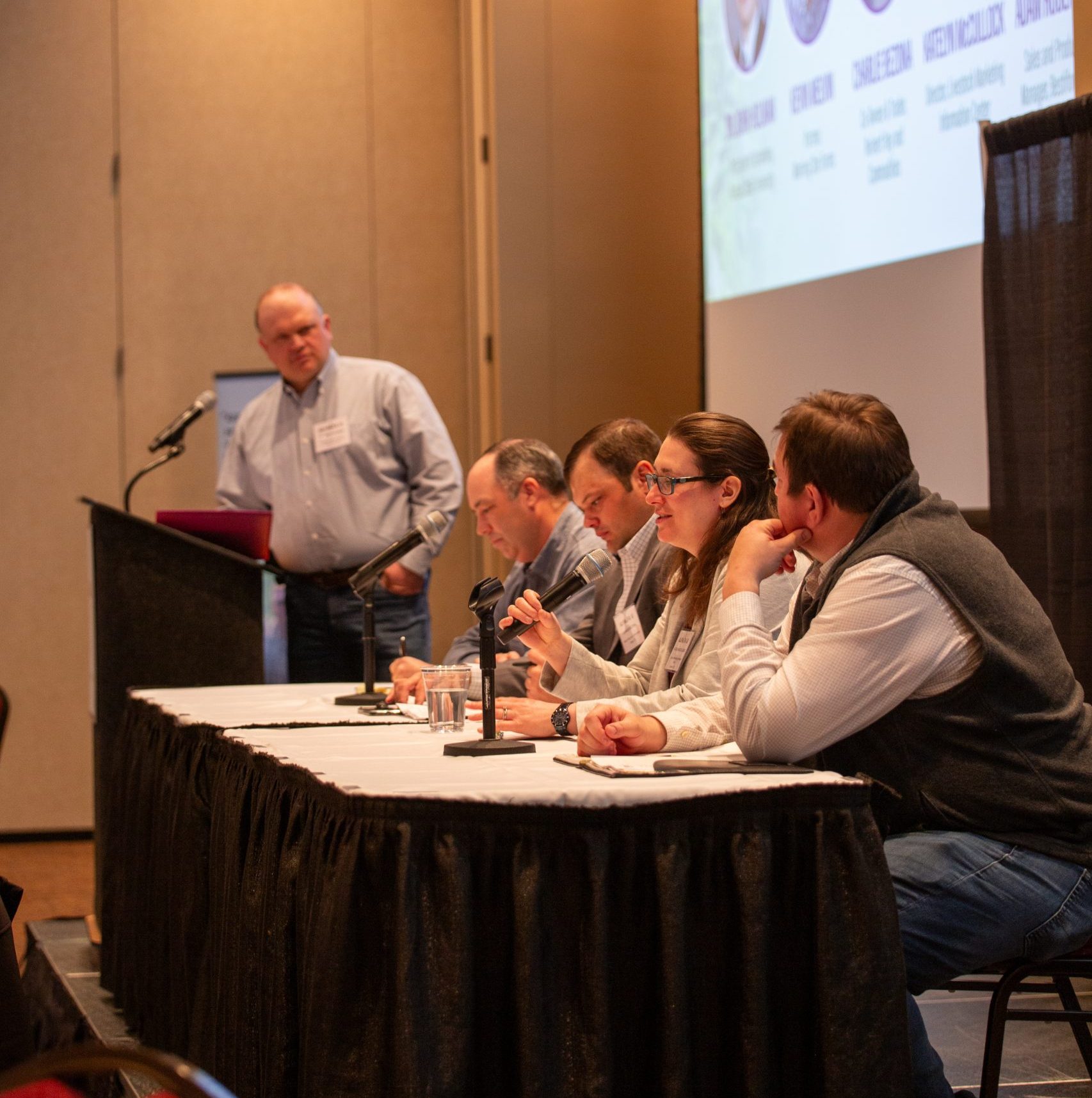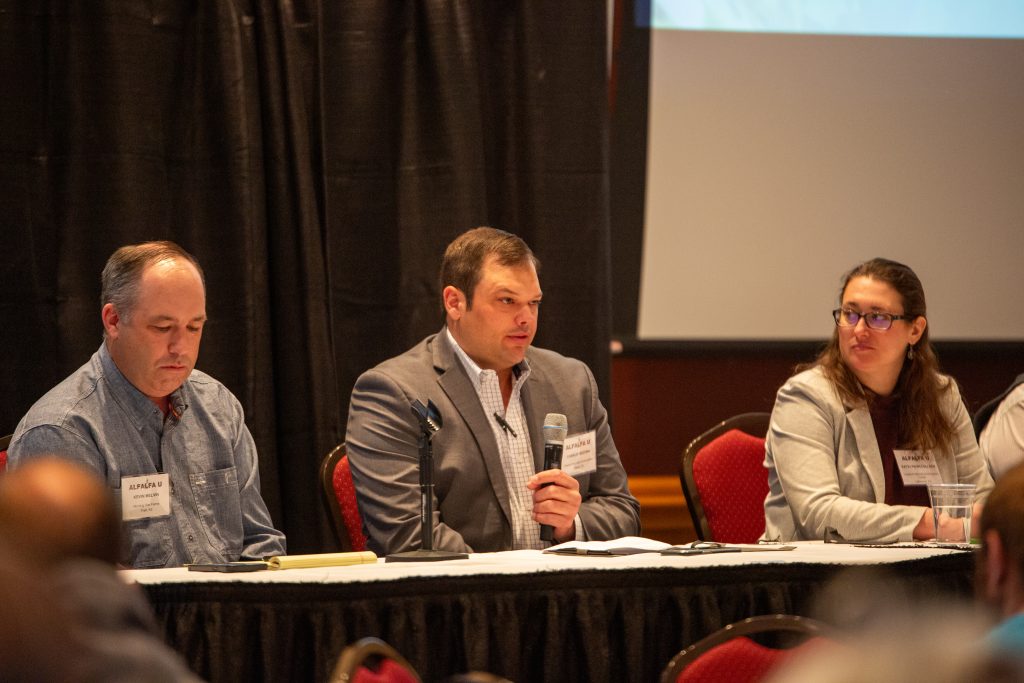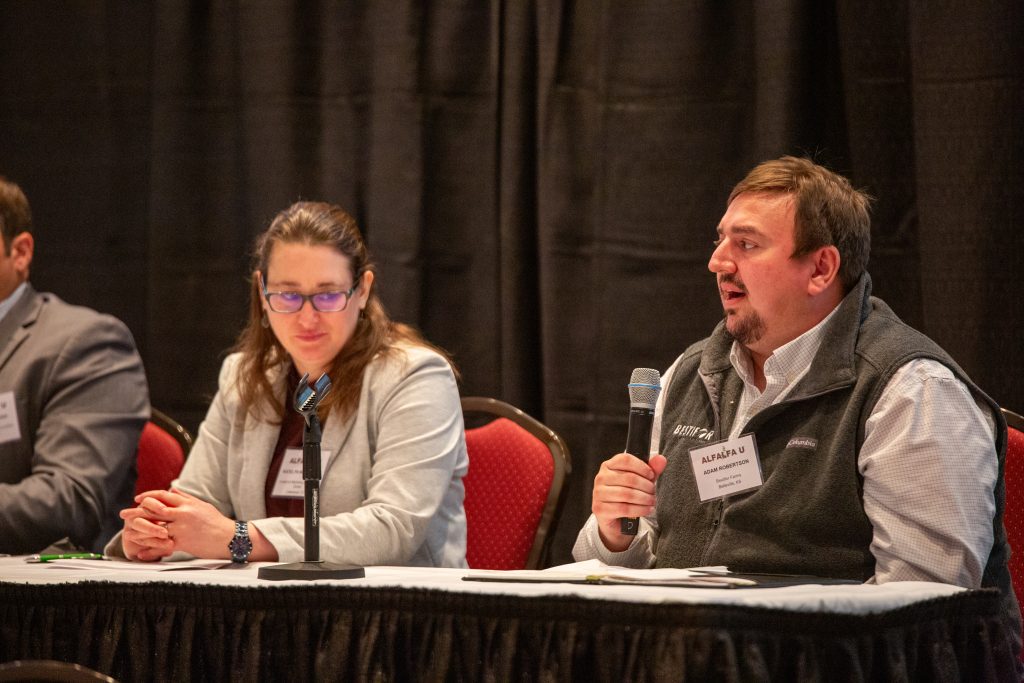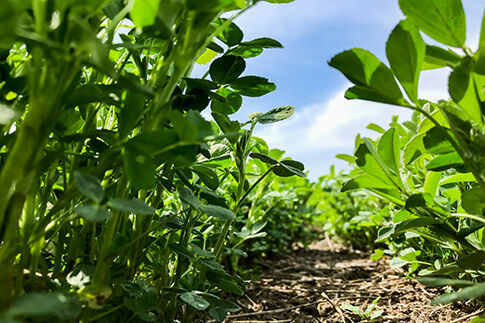Industry panel gives insight on important issues at Alfalfa U

A four-member industry panel at Alfalfa U in Dodge City, Kansas Feb. 27, discussed a number of important issues.
Included on the panel were: Kevin Melvin, partner in MorningStar Farms near Greensburg, Kansas; Charlie Bezona, co-owner and trader, Reinert Hay and Commodities, Hereford, Texas; Katelyn McCullock, director, Livestock Marketing Information Center, and Adam Robertson, sales and production manager, Bestifor Farms, Belleville, Kansas. John Holman, professor of Agronomy at Kansas State University moderated the panel.
It’s no secret alfalfa stands take a long time to establish, and decisions about them can often be a multi-year process. Holman said when there are so many things currently going on in other commodity markets—corn and sorghum prices at around $4 or the cost of feed ration ingredients—where does alfalfa fit into that picture?
McCullock called Holman’s question a loaded one, but went on to ask what about the weather and its influence on alfalfa acres.
“I think, for the last several decades, the number of alfalfa acres has been decreasing. We got a little bit of bump last year. And that was nice to see,” she said. “But generally speaking, alfalfa is competing against high priced other commodities that are constantly battling for acreage. And we’ve seen that in specific states.”
Even with the added acres, she finds it hard to believe alfalfa will get back to the 20 million acres nationally it had once held.
“You have to think production wise, you’re going to only be able to really get substantial gains in that through the yields,” she said. “You might gain a few acres here and there and we have acres increasing slightly, but only by a quarter of a million or so in the next year.”
McCullock sees that as an on-going trend and big gains in acreage probably won’t happen for alfalfa.
“How do you manage that with potentially dry periods, etc,” she said. “And I’m gonna come other commodity front, we have corn prices coming down pretty substantially next year. So you’re not gonna see that correlation both across commodities as well.”
Factors against
Bezona believes there are a few things working against hay prices.
“The dairies are not staying profitable right now,” he said. “When they sign a feed contract to buy or buy any ingredient, they’re locking themselves into a loss. They’re looking for something cheap to feed, and so, alfalfa tends to maybe bring a premium against other ingredients.”
A ot of his dairy customers have kicked alfalfa out of their rations, and are just looking for anything cheap to feed and try to stay alive.
“Unfortunately, I feel like for alfalfa it’s going to have to get cheaper to get back in these rations,” he said. “They will feed it, right, but it’s the right now here’s where the profitability is.”
Alfalfa has to compete with the supply of distillers grains and record spring rainfall last year created a lot of silage piles that some producers are still feeding through.
“These dairies, and feed yards both, they’re paying interest on a monster silage pile here, so they’re going to figure out how to feed their own inventory first before they start buying a lot again,” Bezona said. “What we’ve seen (the dairies are) still feeding alfalfa, the usages have declined quite a bit.”
The feedyards and dairies have to work through some of their cheaper ingredients, and it will take time for them to find what works for their operations.
“I think alfalfa does have some real struggles here to get back into the diet and also net some money,” he said. “Pay the farmer where they need to be paid for producing stuff.”
Robertson agreed, and has noticed the dairymen and feedlots adjusting to what’s available out on the market. Many of them already have a backup plan when alfalfa prices are high.
Sign up for HPJ Insights
Our weekly newsletter delivers the latest news straight to your inbox including breaking news, our exclusive columns and much more.
“They’re smart people just like everybody else. They’re adjusting their ration and they’re saying okay, this is never gonna work for me again,” he said. “They know how to feed when prices are high and when prices go back low then they come back to the alfalfa. I think the value is always going to be there in alfalfa.”

Demand problem?
Holman said alfalfa has a really nice story to tell agronomically—especially since it’s a nitrogen fixing crop and helps increase soil organic carbon over time. That’s important even more so now than before with the regenerative practices in agriculture, and how it plays in to the production side. Could it help with demand problems?
“I think we do have a demand problem,” Melvin said. “You’ve got to break it between hayleage and dry. I think the dry hay has a demand problem. Some of which the market is going to fix itself.”
Water is always a concern for any farmer, and when it comes to water use efficiency for alfalfa, Robertson is sold on an app he uses to track water usage.
“This kind of does that for you—keeps everything in one place,” he said. “It lets you know exactly what your days left to pump. We don’t have any issues with with water management now that we’re using this software.”
Melvin said water is “a pretty hot topic, especially if you get east of Dodge.”
“I think it’s important for Kansas and for us to realize that the the Ogallala is not all Kansas,” he said.
Melvin’s operation uses water out of a different aquifer than many alfalfa growers in southwest Kansas and has water available at about 18 inches instead of 24 like his counterparts to the west.
“I think we all are going to have to find a way to do a little bit less. Pump less water and still get some production,” he said. I think where we’re at, end guns are going to come off. For sure. Most all of ours are already.”
They’ve been experimenting with other water saving technologies to make the most of the water they do have.
“But at the end of the day, the amount of water that you have is either rainfall or irrigation,” Melvin said. “We’ve not found a way to be more efficient really, other than we’d like to pump a little more in the spring and maybe if we run out we’ll run out in August.”
According to Melvin it’s hard to grow alfalfa on a marginal soil profile, and if the profile is full that’s accomplished by watering in the spring—even if he feels like he might run out of water down the road.
“That’s sort of how we manage around that,” he said.
Bezona said the water problem for his area started 30 or 40 years ago, and many are taking action now by transitioning from corn and other high water demand crops to sorghum or wheat that take less water to grow.
“I mean, (they) just won’t even consider alfalfa or corn because the water is not there,” he said. “The Northern Panhandle it’s a super productive area, but there’s just only so much water there.”
Big feed yards and dairies left the Panhandle already and they’re going to where the water is. There’s many areas where the water situation is just as dire, Bezona said.
“I’m not exactly sure what you do about it. I don’t know how you make the water go farther than we’re already trying to do, but it’s gonna be a big problem here in the pretty short term,” he said.
Best decisions
When questioned from the audience about the best decisions the panelists have made when it comes to alfalfa production in the past 10 years and what they see in the future, Melvin said for him, they’re going to have to re-align to what their customers want.
“We’ve made a push into the equine space and certain segments of that it’s, I think, that is key,” he said. “Making sure that our quality is there, even if we take on a few more acres, we’ve got to make sure the quality is there and the quality is stays.”
Storage is important too, and alfalfa producers must take care of the hay. Melvin has implemented a couple of things to help save losses on those bottom bales—even if they’re in the sheds. Plus, he’s serious about trying to find a way to get rid of ash in the alfalfa bales.
“That’s probably our number one complaint from south central Kansas is the ash in the hay,” he said.
Robertson said over the last five years he’s gotten more analytical in the way they do things in the field.
“I think that’s been a big help,” he said. “(As for the ash) we analyze tests. We’ve done trials, we’ve done things to try to get better and mainly like in the grinding side of things.”
He’s analyzed their pricing on each product and what things actually cost. They’re able to offer insight on what customers are wanting to feed the alfalfa to in various rations.
“So we’ve we’ve really used a more analytical approach to everything,” he said. “Trying to figure out how we can improve where the small wins are.”

For more information from Alfalfa U visit www.hpj.com.
Kylene Scott can be reached at 620-227-1804 or [email protected].



